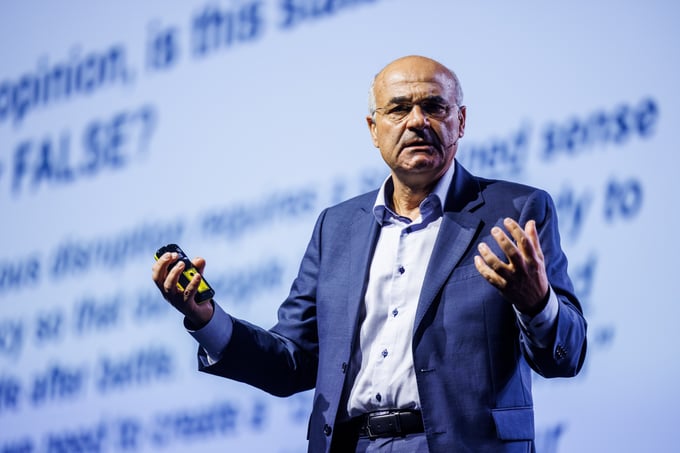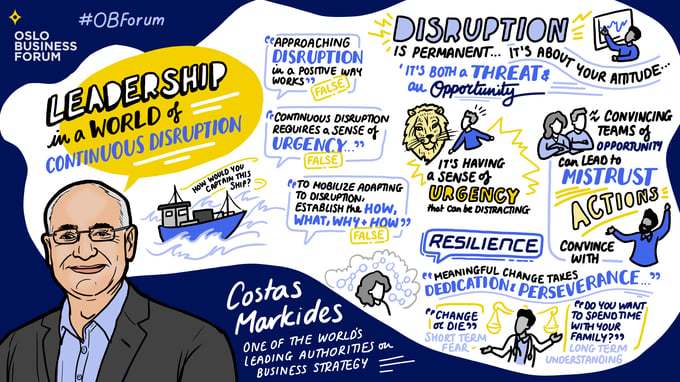When the business world shifts, true leaders pivot. Costas showed leaders at Oslo Business Forum that pivoting isn't just about surviving disruption—it's about dominating it.
Imagine this: You're the captain of a ship in rough waters. You're being hit by a wave. Your life is in danger. You don't know what's going to happen next.
In this scenario, what do you need to be a good captain? What makes an effective leader?
To demonstrate the mindset a good captain needs, Costas revealed some of the biggest misconceptions that guide the average organization's response to chaos. He led the audience through a series of assumptions, asking them if they agreed or disagreed:
Assumption #1: Companies that approach disruption in a positive way and look at them as opportunities rather than threats are more likely to succeed in their response.
Assumption #2: Continuous disruption requires a sustained sense of urgency so that people are always ready to fight battle after battle. To create this sustained sense of urgency, we need to create a burning platform by communicating clearly and honestly to our people about the dangers of failing to respond.
Assumption #3: To mobilize the whole organization to fight against disruption, we must communicate to them what we are trying to do, why we are doing it, and how they can help us do it well.
If you answered "true" to each of these statements, you would be wrong. But you're not alone. In a survey Costas conducted of 750 CEOs in 2019, 96% answered the first question incorrectly, 76% answered the second question incorrectly, and 70% answered the third question incorrectly.
Shocking? Perhaps. But Costas noted that humans often base their actions on false beliefs, and these are some of the biggest mistaken beliefs people hold deep in their hearts.
The CEOs that Costas works with often challenge him, asking, "How do you know you are right?" His response is, "Let's look at the evidence."
In example, Costas discussed the response of U.S. newspapers to the digital distribution of news. Many companies viewed it as a threat, a disruption to their core business. Those companies all failed. Other companies looked at it as an opportunity. They failed, too. It turns out that the only companies that succeeded viewed this digital disruption as both a threat and an opportunity.
Threat or Opportunity?
"In a world of disruption, we have to accept that it is here to stay," said Costas. "It is a feature of our lives. Our attitude determines what we do, how we think about it."
But what is the "right" attitude? Costas contrasted the difference between viewing disruption as a threat or an opportunity, outlining the benefits and risks of both.
1. Disruption as a Threat
Benefits: Generates a sense of urgency, spurs us to action, enables us to respond.
Risks: There is no plan.
2. Disruption as an Opportunity
Benefits: Develop a plan, take deliberate action.
Risks: There is no urgency.
 Costas Markides is a management educator and professor of strategic leadership at London Business School. He is known for his work on strategic disruption and business models, as illustrated in his book, Game Changing Strategies.
Costas Markides is a management educator and professor of strategic leadership at London Business School. He is known for his work on strategic disruption and business models, as illustrated in his book, Game Changing Strategies.
How Disruption Destroys Companies
Costas explained to leaders at Oslo Business Forum how disruption commonly destroys companies. When a "new thing" enters the marketplace, leaders often ignore it. The "new thing" grows bigger and bigger and then begins to cannibalize their business. Suddenly, leaders realize they must respond, so they focus all their attention on the cannibalization of their business. Meanwhile, they have lost sight of the new market created in the periphery of their market.
These leaders failed to view the "new thing" as both a threat and an opportunity. "The theory is clear," said Costas. "You have to look at it as both."
Leading in Continuous Disruption
Adopting this mindset is a challenge for most leaders. Even if they say that disruption is both a threat and an opportunity, it's difficult to convince the people they lead to view it in the same way and to travel with them through the rough waters.
Costas helped leaders understand the two biggest challenges they must navigate today: convincing the people they lead that disruption is an opportunity and making people resilient enough to withstand obstacles and setbacks. The answer lies not just in HOW you lead but in WHO you are.
How to Inspire Belief
The first big challenge for leaders is to inspire belief in their people. "When people are surrounded by disruption and fear of what's coming, it is hard to convince them there is something positive there," said Costas.
Leaders can make people believers by giving them a positive goal, selling the goal, and winning their emotional commitment to it. Costas believes that when people truly believe in something, nothing can stand in their way.
"Win their emotional commitment."
.jpg?width=680&height=454&name=IMG_8981%20(1).jpg)
"It is not enough to communicate the "what," "why," and "how" to win your team's commitment. You need to make people care. "You have to win their hearts," he said. "And you're not going to do this with a PowerPoint presentation."
Leaders must remember that their actions speak louder than words. Costas used this as an example: "When everyone else is firing people, are you hiring to get ready for the opportunity that will come after that crisis?"
How to Build Resilience
The second big challenge for leaders is to build resilience in their people. How do you convince people to find the energy to get up and fight again despite running into obstacles and setbacks?
Costas pointed to a study on people who underwent major heart surgery in the book Change or Die. Following their operations, they were told they must change their habits to improve their health.
In the short term, everyone changed. But, after the second month, 90 percent of patients reverted to their previous bad habits. How did the other 10 percent persist? The answer was in how their doctors explained WHY they needed to change.
"Focus on the 10 percent."
The majority of the patients were told to change or die. "Scaring people creates urgency, but it is not sustainable," said Costas.
Ten percent of the patients were told to think about the benefits of changing and the costs of not changing. "What makes people resilient is that they believe in a positive goal that makes every effort to achieve it worthwhile," Costas said.
Show Them You Care
"In difficult times, how you [lead] is important, and so is who you are," Costas said.
Costas believes agility is one of the most important traits of a good leader. "Agility is not new, but in today's context of continuous disruption, it is more important than ever," he said.
How do you embed agility in the DNA of your organization? The first step is to give people autonomy.
Costas acknowledged that the challenge for most leaders who want to give their team autonomy is how to do so without losing control. To demonstrate the right approach, he used an example from his experience as a parent.
As a parent, you help your children make decisions and act based on the values you have instilled and the rules you have established. You help them learn the difference between right and wrong, and you set boundaries for their behavior.
Likewise, in business, you must set parameters in place for decision-making. If a decision falls within the parameters you set, your team has the authority to act. If it does not, they must come to you. "The biggest parameter in business is the strategy you have set," said Costas. "Make sure your people know your strategy and the choices you have made." 
Issuing a Challenge to Leaders
The most successful leaders learn not just to adapt in a disruptive environment, but to thrive and capitalize on every twist and turn. The trick is to convince your team to plant the flag with you. To do that, you must show them you care.
Costas left leaders at Oslo Business Forum with a challenge. He asked them, "Are you going to be part of the 90 percent who know how to do it but never do it, or are you going to be part of the 10 percent who translate knowledge into action?"
Key Points
- Approaching disruption as a threat has both benefits and risks. Approaching disruption as an opportunity also has benefits and risks.
- The biggest challenge leaders must navigate is framing disruption as both a threat and an opportunity.
- Leading in continuous disruption requires you to inspire belief and build resilience in your team. You must help people believe in a positive goal to make them resilient.
- The secret to effective leadership lies not just in HOW you lead but in WHO you are. You must show people that you care.
- One way to demonstrate care is by giving autonomy within the parameters of a clear strategy.
Questions to Consider
- How do you view disruption? Can you shift your perspective to view it as both a threat and an opportunity?
- Have you made believers of your people? Do they trust what you say?
- How resilient is your team? Are there steps you can take to increase their ability to withstand disruption?
- How many of your employees understand your strategy? Are they equipped to act autonomously and make decisions that align with it?

Want to be a part of the OBF community? Join Oslo Business Forum 2024: Courageous Leadership now!
